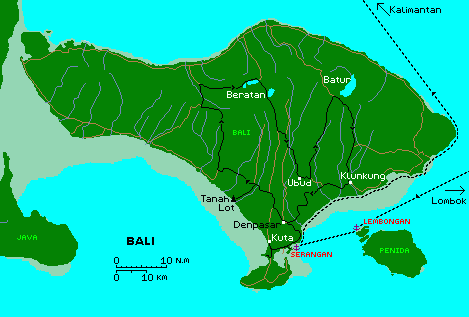
Bali, with our sailing (dotted) track and driving (black) routes shown
|
Indian Landfalls Indonesia Pages Related Pages |
Bali
 Bali, with our sailing (dotted) track and driving (black) routes shown |
Major islands: Bali, with small Lembongan to the east.
Population: The Balinese people comprise 95% of the almost 3.2 million
inhabitants of this relatively small island.
Religion: Hinduism, Islam.
Language: Balinese and (officially) Bahasa Indonesia.
Landscape: Bali is extremely mountainous with several active volcanoes
and deep lakes. The land is fertile and lush.
Visited: 18 September through 2 October, 2006.
For more info and photos see our "Beautiful Bali" newsletter which also covers some of our adventures in Bali.
History: Very little is known of Bali and its interactions with the surrounding area and traders much before 11th century AD. Undoubtedly, though, Hinduism arrived with Indian traders in the early centuries and took hold. Archeological evidence shows that by the 9th century AD the Balinese people had already developed their intricate irrigation system for rice cultivation. From 1019 to 1042, Bali came under domination by neighboring Java under the reign of King Airlangga.
After his death, Bali reverted to its semi-autonomous state, but it wasn't until the late 1200's that Bali's own Pejeng Dynasty, centered around the hill town of Ubud, rose to great power. But it was short lived, for less than a half century later the Javanese again conquered the island and brought Bali under the rule of the Majapahit kings. For the next 2 centuries the King of Bali (under Java) ruled from Klungkung Province in the southeast of the island, and it was during this time that Lombok was brought under Balinese rule. In the 1400's with the Majahapit Dynasty declining rapidly, many of the intelligentsia and artisans of Java fled to Bali bringing with them many of the ideas that are now seamlessly imbedded in Balinese culture, art and religion. Bali regained its autonomy but kept a firm hand on the neighboring island of Lombok.
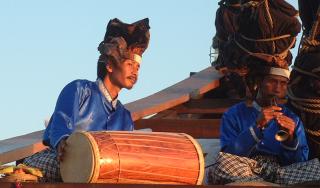 Balinese musicians on a traditional boat |
Dutch sailors arrived in 1597 and were so taken with the Balinese way of life that when ordered to set sail, many elected to stay behind. But in general the Dutch were not interested in culture so they lost interest in the island that seemed to offer far less than the spice islands to the north or the trading advantages of the Malay Peninsula. Not interested, that is, until goods-laden ships were wrecked on the Balinese coasts and the Dutch used the salvaging of these ships as excuses to land military forces and interfere in the politics of the region.
 Balinese temple entrance |
In 1894 the Dutch sided with the Sasak people of Lombok in a rebellion against the heavy-handed Balinese kings. By 1906 the Dutch controlled much of the north, but several small kingdoms remained independent in the south. Refused payment for salvage rights on a Chinese trading ship, the Dutch assaulted the town of Dempasar. The Balinese kings, rather than face humiliating defeat and exile chose the Balinese honorable way out -- puputan -- suicidal fights to the death. Despite pleas from the Dutch for surrender, more than 4,000 Balinese nobles dressed in full battle regalia marched to their deaths under Dutch guns. Thereafter, the Dutch were fully ensconced in Bali which became part of the Dutch East Indies.
It was the bombing of Pearl Harbor, and the Japanese invasion of SE Asia which saw the beginning of the end of Dutch rule in the region. After WW II, when Indonesian leader Soekarno proclaimed independence, it still took 4 years to wrest control of Bali from the Dutch. The 1960's saw the beginning of western tourism on the island, but was also a time of several disasters: one was natural, with the eruption of Gunung Agung which killed thousands, the other man-made with a bloody purging of communists and those suspected of being sympathizers, including a large percentage of the Chinese population. Tourism boomed in the 1970's and the island's infrastructure took off. Sadly, terrorist activity put an end to the tourism boom in 2002 when Westerners were targeted in a bombing in the narrow streets of Kuta, killing hundreds, including many Balinese. A second set of bombs in 2005 further destroyed the sense of an idyllic island culture. That terrorists should target such an easy and peaceful culture shows just how cowardly the terrorists really were. Bali is still shaking off the horror of these events, and puts out a plea to the world to come see their beautiful island.
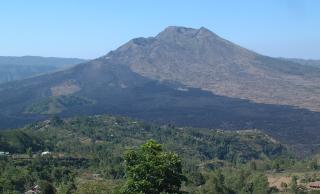 Bali's Gunung Batur, showing the 1974 lava flow |
(Jon) Bali was so different from the rest of Indonesia that it could easily be its own country. It had by far the most vibrant economy we saw in Indonesia, and a very different, predominantly Hindu, culture. Fields were cultivated instead of the lying barren or burned off like the hills we saw in Nusa Tenggara. Roads were good, the infrastructure all worked, and the people didn't look at us like we were some kind of gods who'd arrived in our space-ships. The Balinese people had their own lives to lead and, while polite, didn't really need us, which was nice. Prices were so good on local furniture and crafts that cruising friends commented that if they ever moved ashore, they were going to come to Bali and fill a container with all the furnishings and artwork they needed for their house.
 Beautifully terraced rice fields in central Bali |
Bali was, of course, a major stop for the Darwin-Indonesia Rally, and we got to attend several events. Apparently, Bali is divided into many "Regencies", and several wanted to show us their culture. So the rally organizers arranged several busses and 3 full days were devoted to driving to the different Regencies to watch cultural shows (mainly music and the very stylized Balinese dancing), watching handicrafts being made, and, of course, eating sumptuous meals. Problem was, the busses had police escorts, and therefore paid no attention at all to any traffic regulations, driving down the middle of the road or even on the wrong side of the road if traffic was backed up. More descriptions of this can be found on our Beautiful Bali newsletter page.
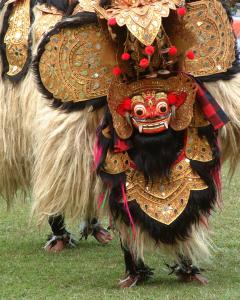 The popular Barong dance |
Sue, unfortunately, missed these cultural shows as she had to fly home suddenly when her mother was critically ill. So when she returned, we rented a car and drove into the highlands, showing her some of the sights we'd seen earlier but taking the time to explore on our own. This revealed a very different culture to the rush and hustle that we'd seen around Denpasar (the capital) and the tourist areas like Kuta Beach. Here were terraced rice fields quietly being worked by hand and oxen, ancient temples still being used, saffron robed priests murmuring prayers amid clouds of incense and leading parades of the faithful down country roads, welcoming us (if we dressed appropriately) and offering to let us join them. At night we stayed at a small guest-house in the highlands, savoring the cool breezes and strolling the streets looking for yet another wonderful meal. Bali truly is a delightful part of the world.
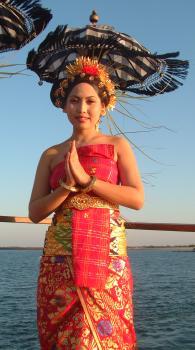 Beautiful traditional dress |
(Amanda) Bali certainly is different from the rest of Indonesia, with a good tourist trade and more of a middle-class economy, and a very colorful way of life. Color seemed to be everywhere, even in the little offerings people left in personal shrines or on the sidewalk in front of their homes. The traditional dress of the Balinese is layers and layers of ikat and songket in every color imaginable, the bolder the better! And the temples... with Mom gone I had primary control of the camera, and I just couldn't stop taking pictures of the temples. The intricate gold filigree, red and green and yellow paints, it was just beautiful having all these colors leap out.
Though it was nice to see some plain work too. In one town of artisans we visited, we were able to watch some men re-building a temple - pouring concrete into square molds and then carving the beautiful dragons, lions, and monkeys that usually adorn the corners of roofs and entrances to temples. The work is exquisite, and in those cases the restraint from color is just as powerful an image as the use of it.
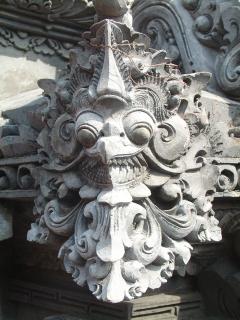 Intricate carvings on the shrines |
Keeping on the subject, the Balinese even send their dead off with a burst of color. We were able to witness a royal cremation in Ubud, up in the hills. The hand carried tower that they carried the casket in was over 50 feet (15m) high, probably depicting many Balinese gods but doing so in a feast of color and expression. The wooden and papier-mâché cow that they burned was mostly black, but adorned with gold horns, bells, and necklaces. Read my Bali Cremation journal for more on this.
When I think of Bali, the first thing that comes to mind is all the temples, but that wasn't all we saw. Another image I have of Bali is of its striking lushness and greenery. We didn't see any forests, per se, but the rice fields stretched for miles without stopping, green as far as the eye could see, interspersed with crude scarecrows and little huts where rice-watchers stayed. Even on hills that seemed impossibly steep, rice grew on long, contouring terraces that looked beautiful (but seemed too much trouble for the amount of rice they produced).
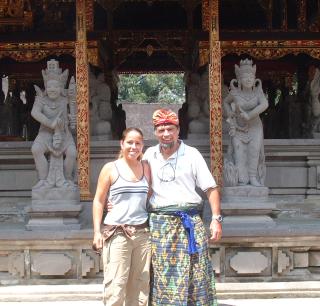 Amanda and Jon in a Balinese temple |
The car trips and bus tours were awesome, even if the streets terrified me and we did get rather lost trying to get to Ubud when we were stuck on the wrong side of several rivers. I was elected to be navigator and had to find us a (nearly non-existent) road which crossed over. Somewhere along there I had the doubtful pleasure of coming face-to-face with a chicken as it launched itself off the steep bank on the side of the road right at my (thankfully) closed window. Gave me quite a fright, and I'm not sure the chicken fared any better - we managed to get to Ubud, though!
I could have stayed longer up in the hills of Bali, where it was cool and fresh and away from the mad tourism which fills the streets of Kuta. But we were already later leaving Bali than most other rally boats, and we'd have to hurry if we wanted to see Kalimantan and the orangutans, so we sadly said goodbye to the green fields and gold temples of Bali and sailed off once more.
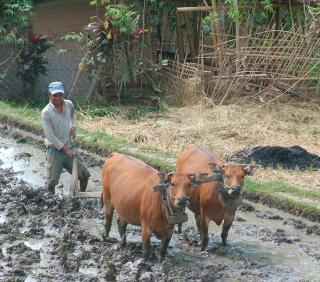 Buffalo plowing a rice paddy for the new crop |
(Sue) I was told by a cruising friend in the 1980s that if he were to have children, and have a choice of where to have them and raise them he would go to Bali. I have held in my mind for all these years a picture of tropical, mountainous paradise, with lovely gentle people who value human life and treasure their children. Upon our arrival in Bali in 2006 it took quite awhile to find some reality to these long-held images. At first glance the island is overpopulated, overrun by traffic and air pollution, with tourist shops vying madly for customers in this post-bombing era. (Terrorist bombs exploded in 2002 and 2005 in much-touristed areas outside the capital of Denpasar, killing hundreds.) But after seeing a documentary film on the bombings and the Balinese response (which is to pray for self-understanding of what they were doing to focus such rage upon themselves, and to pray for peace) I began to understand something of the Balinese culture. It is also a sad truth that many more aggressive people from over-populated Java are pouring into Bali, dominating and flooding the tourist market with shops, hawkers and wild taxi driving.
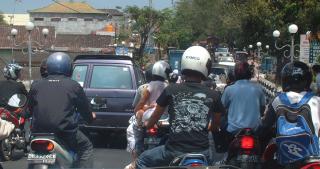 Traffic jam? Typical road in Denpasar |
Jon and Amanda had already done a fair amount of touring in Bali while I was in the States on an emergency trip, but it wasn't hard to persuade them to rent a car for the three of us and go touring. Traveling inland where the hills are verdant with rice fields, I finally saw the physical beauty of this island, and enjoyed quiet interactions with some of the Balinese people. Even an impromptu lunch stop at a guest house in the hills, seated in the shade on a terrace above a rice field, surrounded by landscaped gardens, imparted a deep sense of peace.
 Temple offerings -- a religious art form in Bali |
High in the hills we drove into a village where the streets were lined with cloth-draped bamboo poles heralding a festival. Sure enough, the main temple in the town center was a magnet for stately, well-dressed Hindu women and children arriving with baskets laden with offerings. We donned our sarongs (yes, even Jon wrapped his legs in a flower-patterned sarong!) and approached the temple steps. Gesturing, and using limited Bahasa Indonesia we asked permission to enter. "Boleh?" I asked. "Selamat datang," (Welcome) they replied.
 Balinese artistry reflected in the gardens |
Inside on the left was a 20- or 30-man orchestra playing drums and bamboo gamelan (traditional xylophones). Ahead were altars and tables laden with baskets beautifully decorated with offerings of fresh fruit, (cooked) chickens and flowers. On the right, in the shade, sat about 20 men passing bowls of food from one to the other. With such joyful expressions of religion it is hard not to be drawn into the beauty that characterizes the Balinese people. In small villages under towering volcanic mountains or surrounded by rice fields I felt like I was seeing the ancient Bali of my dreams where village life centers around temple life, dance, music, and prayer. Bali is a world apart from the rest of Indonesia, and if it weren't for being able to use my bits of Indonesian language and read the signs, I would have very easily believed that I was no longer even in Indonesia.
Indonesia Destinations:
Related Pages:
Indian Ocean:
Top Level: Home | Destinations | Cruising Info | Underwater | Boat Guests | Ocelot | Sue | Jon | Amanda | Chris | Site Map | Make a Comment
|
If our information is useful, you can help by making a donation |
Copyright © 2000‑ Contact: Jon and Sue Hacking -- HackingFamily.com, svOcelot.com. All rights reserved.